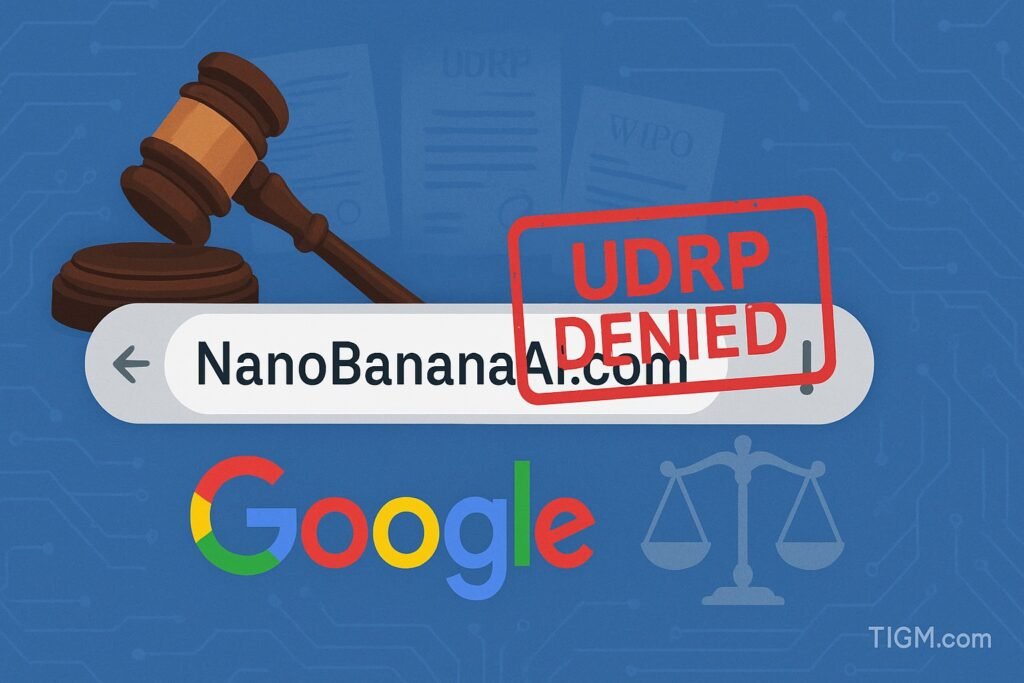In a surprising defeat, Google LLC lost its UDRP complaint seeking control of NanoBananaAI.com. The National Arbitration Forum denied Google’s request on October 28, 2025, ruling the company failed to demonstrate sufficient trademark rights in “Nano Banana” despite compelling evidence of bad faith by the domain holder.
The Case Background
Google launched its “Nano Banana” AI-powered image editing software publicly on August 12, 2025, through its LMArena platform. The software quickly gained attention on social media and tech publications, with Business Insider covering the launch on August 19, 2025.
Just two days after Google’s launch, respondent Ping Lin of China registered both NanoBananaAI.com and NanoBanana.ai on August 14, 2025. The domains promoted a competing AI image generation service under the identical “Nano Banana” name.
Google’s Evidence of Bad Faith
Google presented substantial proof of targeting and bad faith use. The respondent’s website claimed its service ran on “Gemini 2.5 Flash Image”—Google’s own language model—and included source code references to Google’s VEO and GEMINI trademarks. On X (formerly Twitter), the respondent reposted Google content suggesting false affiliation, including reposting a Google Gemini App promotion with “Let’s all go bananas” commentary.
Google also alleged a pattern of behavior, noting the respondent had similarly registered Veom.ai just two weeks after Google launched Veo 3, its AI video generation software. The opportunistic timing—registering domains 48 hours after Google’s public launch—demonstrated clear targeting.
Why Google Lost
Despite compelling bad faith evidence, panelist David E. Sorkin ruled against Google on the fundamental first UDRP element: demonstrating trademark rights. Google relied on common law trademark rights rather than a registered trademark, which requires proving the mark has become “a distinctive identifier which consumers associate with the complainant’s goods and/or services.”
The panel found Google’s evidence insufficient for several critical reasons. First, Google had used “Nano Banana” publicly for only six weeks before filing (August 12 to September 29, 2025). Second, Google provided no sales data, advertising expenditure figures, or comprehensive market recognition evidence.
Most damaging: Google never publicly claimed trademark rights in “Nano Banana.” The name doesn’t appear on Google’s official trademark list at its brand resource center, and Google’s web pages contain no trademark symbols or rights assertions.
Panelist Sorkin emphasized that “the fact that a respondent has targeted the putative mark is relevant but not sufficient to demonstrate acquired distinctiveness.” Bad faith targeting alone cannot compensate for lack of established trademark rights.
Key Takeaways
This decision carries significant lessons for companies and trademark holders. Launching quickly doesn’t automatically create trademark protection—even major brands need time to establish secondary meaning for new product names. Companies should file trademark applications immediately and publicly assert rights from day one, not rely on post-hoc arguments after disputes arise.
Under UDRP, common law trademark claims face substantially higher evidentiary standards than registered marks. Google’s reputation and resources couldn’t overcome insufficient evidence—panels apply identical standards to all complainants regardless of size or prominence.
The timing proved critical. Google’s filing came just 46 days after launch, likely too soon to accumulate sufficient secondary meaning evidence.
What’s Next
NanoBananaAI.com remains with Ping Lin. Google can file trademark applications and potentially refile UDRP after registration, pursue federal litigation under different legal standards, negotiate purchase, or continue building brand recognition for future action. A separate UDRP proceeding over NanoBanana.ai remains pending.
The decision surprised trademark attorneys who expected Google to prevail given obvious targeting. However, it reinforces UDRP’s strict evidentiary requirements—rights in a mark serve as a threshold issue that must be satisfied regardless of bad faith evidence strength.
For companies launching new products, this case delivers a clear warning: protect trademarks early, file applications immediately, publicly assert rights, and document everything. In fast-paced technology sectors, even a few months’ delay in establishing brand recognition may prove fatal when opportunistic registrants monitor product launches.
Case Reference: Google LLC v. Ping Lin, FA2509002179459 (NAF Oct. 28, 2025)
For Full Decision- Click Here








